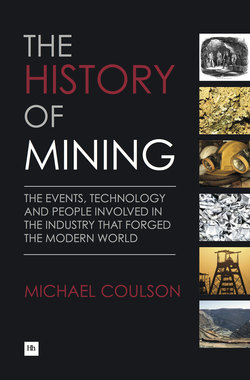Читать книгу The History of Mining - Michael Coulson - Страница 18
На сайте Литреса книга снята с продажи.
Asia Minor
ОглавлениеThe area historically known as Asia Minor includes Anatolia (modern Turkey) and in terms of ancient trading relations it also touches on Syria, Mesopotamia (modern Iraq), Persia (modern Iran) and Armenia. Assyria (the ancient empire that covered parts of the region, expanding and contracting over the centuries) was one of the ancient world’s most advanced civilisations and was an important factor in the emergence of the Bronze Age in the 3rd millennium BC. At its height in the 1st century BC, the Assyrian Empire was also a highly developed society which had embraced technological change and had pioneered a number of advances including a basic electric battery which may have been used in the process of treating silver. Some historians even call Asia Minor the Cradle of Civilisation.
It is therefore not surprising that this region was the centre of a vigorous trading system where Anatolia was the great mining and metal working nation and exported finished metal to its near neighbours. For example, the ancient tin mine at Kestel and the associated smelting site at Goltepe in central Turkey reach back as far as the 3rd millennium BC.
Copper artefacts have been found all over the broad Asia Minor region; the oldest is thought to be a pendant from the 9th millennium BC found at Shanidar in the Zagros Mountains of north eastern Iraq. Archaeologists have also found copper objects at Cayonu Tepesi in Turkey that have been dated to the 7th millennium BC. Further finds of copper artefacts from the 6th and the 5th millennia BC in Iran and Turkey have also been uncovered. Much of this early copper would have been native, released from rock by weathering over thousands of years. As we have observed in other ancient mining areas, the very earliest use of metals was based on a supply of pure material simply picked up off the ground, a phenomenon that we will come across later in the tale of diamonds in Namibia’s deserts in the 19th century AD.
A relatively sophisticated trade in copper and copper objects developed over the millennia in the extended area of Asia Minor and the Middle East, and it is quite likely that the growth in this trade put pressure on the supply that was being obtained from native copper findings. Since we are talking about the cradle of technology as well as of civilisation, the response to possible copper supply problems would have been to examine how the pure copper metal had got where it had. Here we are just guessing, but it is likely that very early fossickers saw copper streaks in rock and worked out that these were similar to the native copper that they had been picking up off the ground.
From here it would have been a matter of developing the processes to extract the copper from the rock. The secret would have been the ability to generate sufficient heat in a rock furnace to melt the copper out of the ore and then separate the two – metal and slag – leaving a relatively pure copper residue. It is believed this smelting technique was developed around the 4th millennium BC.
One of the most interesting metal mining, smelting and manufacturing sites found in Asia Minor is the Medzamor complex immediately to the east of Turkey in Armenia, which is thought to date back as much as 5000 years. Medzamor was uncovered in the 1960s by Soviet scientists and archaeologists and some western opinion at the time was a little sniffy about its significance. Dozens of smelting furnaces were found and evidence of multiple working of metals covering both copper and other base metals as well as gold. All sorts of metal products were uncovered – including vases, bracelets, rings, spearheads and knives. This suggests a settlement specialising in industrial activities emanating from mining, contrasting with the traditional farming settlements more associated with simple ancient lifestyles.
